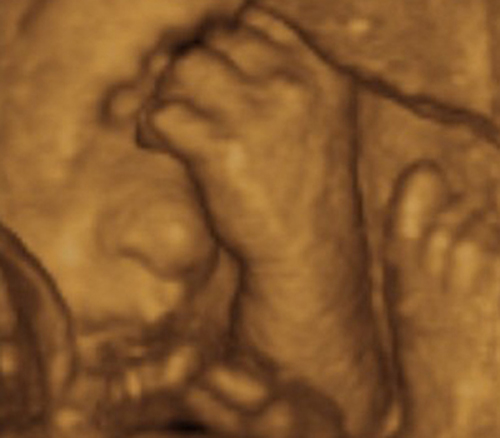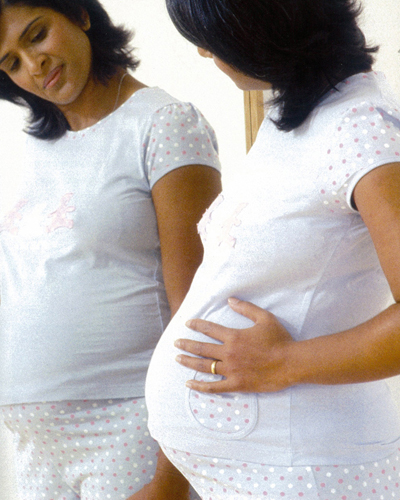You are 29 Weeks and 4 Days 73 days to go…
Your baby is cushioned in a sac of amniotic fluid, which surrounds her until your water breaks and you go into labor.
Your baby today
In this image a hand is held up to the forehead and, to the
right, part of a foot can be seen. The groove between the nose and the
upper lip is visible and the nose has the characteristic “button” shape.
It looks cramped in there but there is still room to move.

As your uterus
has enlarged throughout your pregnancy, the amniotic sac has expanded
to accommodate both your baby and the amniotic fluid. From now on,
however, the sac will grow by simply stretching rather than forming new
cells.
The amniotic sac is
formed from two distinct layers or membranes, an inner “amnion” and
outer “chorion.” The chorion originally had a blood supply of its own,
but this has now been lost. The thinner amnion is able to slide over the
chorion as your baby pushes against it. Neither layer contains nerve
cells: this explains why it’s not painful when your membranes rupture or
“water breaks.” Combined, the layers are only 0.5 mm thick. Collagen
fibers in each layer allow for a great deal of stretch—this is vital in
these final months to avoid early rupture of the membranes. Indeed, the
membranes may be so resistant to rupture that they don’t break until the
final stages of your labor .
In addition to holding
in the amniotic fluid and providing a barrier to possible infection
through the cervix, the membranes contain substances that form
prostaglandins. Prostaglandins play an important part in the initiation
of labor. This is one of the reasons why labor often starts when the
membranes have ruptured.
The only reliable way to discover the sex of your baby is to have a diagnostic test, such as amniocentesis or chorionic villus sampling.
Even ultrasound can
be wrong. And despite the common belief that the size and shape of your
belly indicate gender, these are in fact determined by your muscle tone,
your baby ‘s position, and your weight gain.
… Dads
Kicks and hiccups
By now, it’s possible to see and feel
your baby moving, often with kicks and punches. This may happen more
often in the evenings, when your partner finally gets to sit down and
relax. Watching your baby’s movements can be a great way to bond with
her, and with your partner.
Your baby will respond to your voice, to music, and may even jump at unexpected noises ; it’s impossible to say whether this is because these noises are enjoyed or because they’re irritating.
Your baby will also hiccup sometimes
and you have a better chance of feeling her moving while she’s
hiccuping than any other form of movement. This is because hiccups occur
over prolonged periods of time, while kicks and punches can be fairly
random.
Your baby may have
several episodes of hiccuping in a day, or only one or two—you will
both be able to feel these as a series of light, rhythmic movements.

You are 29 Weeks and 5 Days 72 days to go…
Regardless of your size—and that of your baby—nature won’t let her grow too large for you to be able to give birth.
Your baby today
The lip shape and groove between the nose and upper lip are
particularly well shown here. If you or your partner has a prominent
groove, or philtrum, above the upper lip, your baby may too, or she may
inherit characteristics that are somewhere in between.

Your body shape
isn’t an indication of whether you’ll have an easy birth. The size of
your hips is not always a good indication of the size of your pelvis so
having slender hips doesn’t mean you’ll have a difficult birth, and
having larger “child-bearing” hips doesn’t mean you’ll have an easier
birth.
What is known is that,
although how big your child will be is determined genetically, women
have an extra influence on the size of their babies while they are in
the uterus. So, even if your child ends up growing to 6 ft (1.80 m)
tall, if you’re small you’ll limit how big she gets in the uterus. This
makes sense—if you’re small, you wouldn’t be able to deliver a hefty 12
lb (5.5 kg) baby, so your body limits the baby’s size at delivery. Your
baby will then catch up on her expected growth after the birth.
There’s a condition
called cephalo-pelvic disproportion in which the baby is too big or the
pelvis is too small for the baby to engage. An MRI scan will be
performed to get exact measurements.
As you marvel at the size of your belly, you may be concerned about how you’ll ever deliver your baby. But don’t worry—nature is on your side.

… Doctor
| Q: |
What will happen when I go for a gestational diabetes screening?
|
| A: |
You’ll be given a very sugary drink and asked to wait for an
hour, after which your blood will be tested. If your levels are high,
you’ll have to take a glucose tolerance test, which is similar, but
longer. If you do have gestational diabetes, you will be taught how to
test your blood sugar at home. You’ll likely be able to control your
condition with diet and exercise.
It’s reassuring to know that most women who have sugar in their urine have normal blood-sugar levels in the glucose test.
|
A support network
After giving birth,
your body will spring back into shape overnight; you’ll be bursting with
energy and raring to go. That’s one scenario! The other—more
realistic—possibility is that you’ll find yourself struggling to get
breast-feeding established and to brush your teeth before lunch time. If
you don’t like living in a mess, act now to prevent resentment (and the
laundry) from building up in a few months’ time.
Talk to your partner now about how you’re going to split the chores once you’re parents.
Your “job” will be to nurture your newborn,
so you’ll need domestic backup, if possible, particularly during the
first few weeks. Recruit helpers (family and friends; or pay
professionals if needed). Delegate so that you won’t have to think about
shopping, cooking, or cleaning.
New parents need their own space,
so it’s never too early to arrange for some babysitters for a few weeks
after the birth. If you’re breast-feeding, you’ll need to express your
milk.